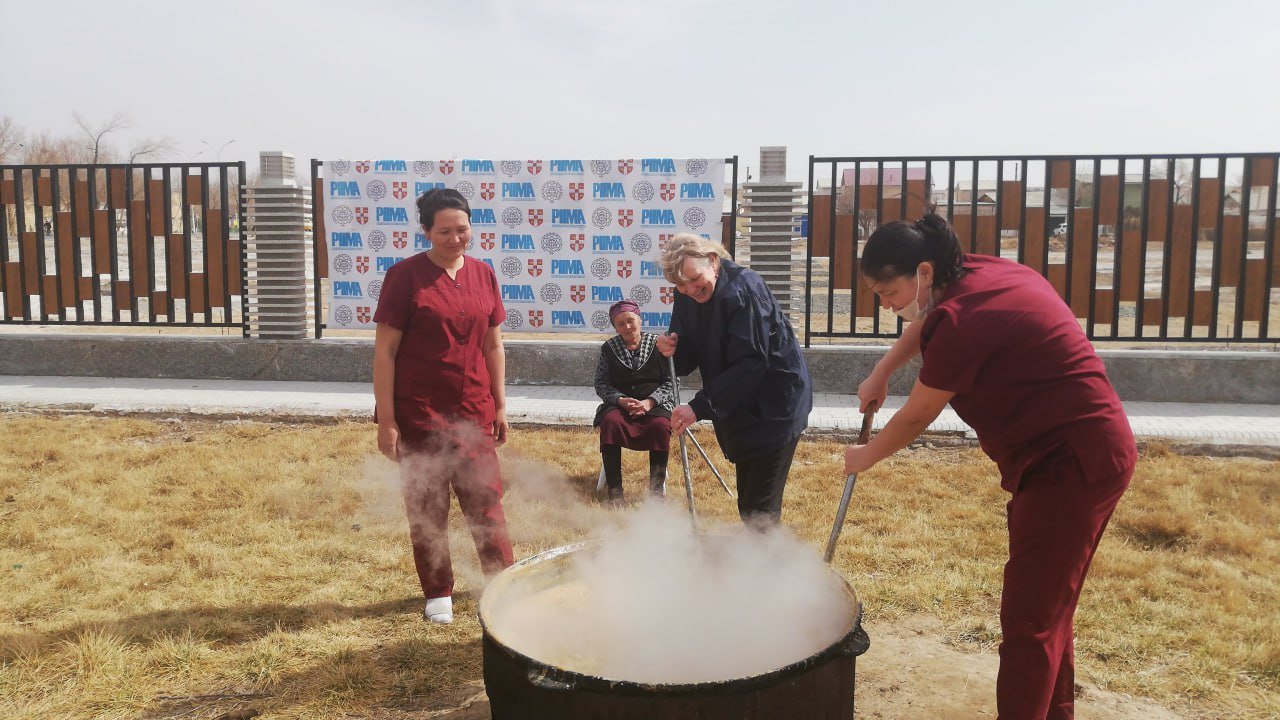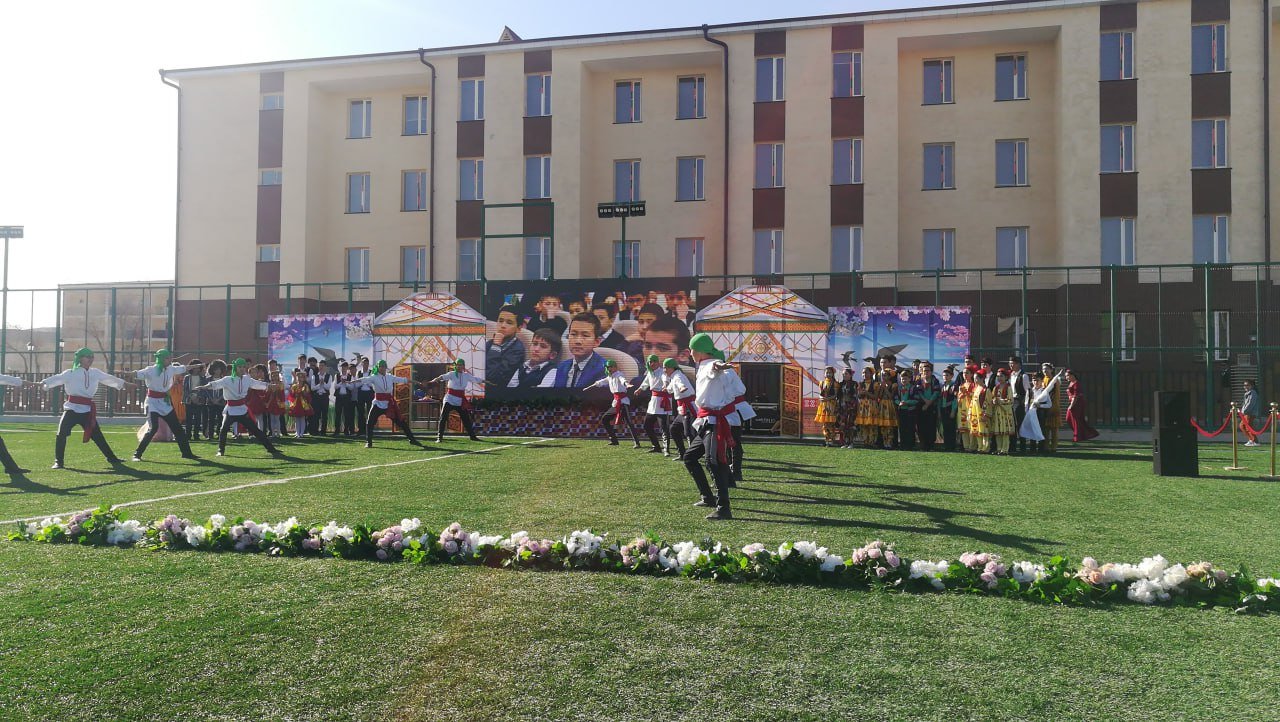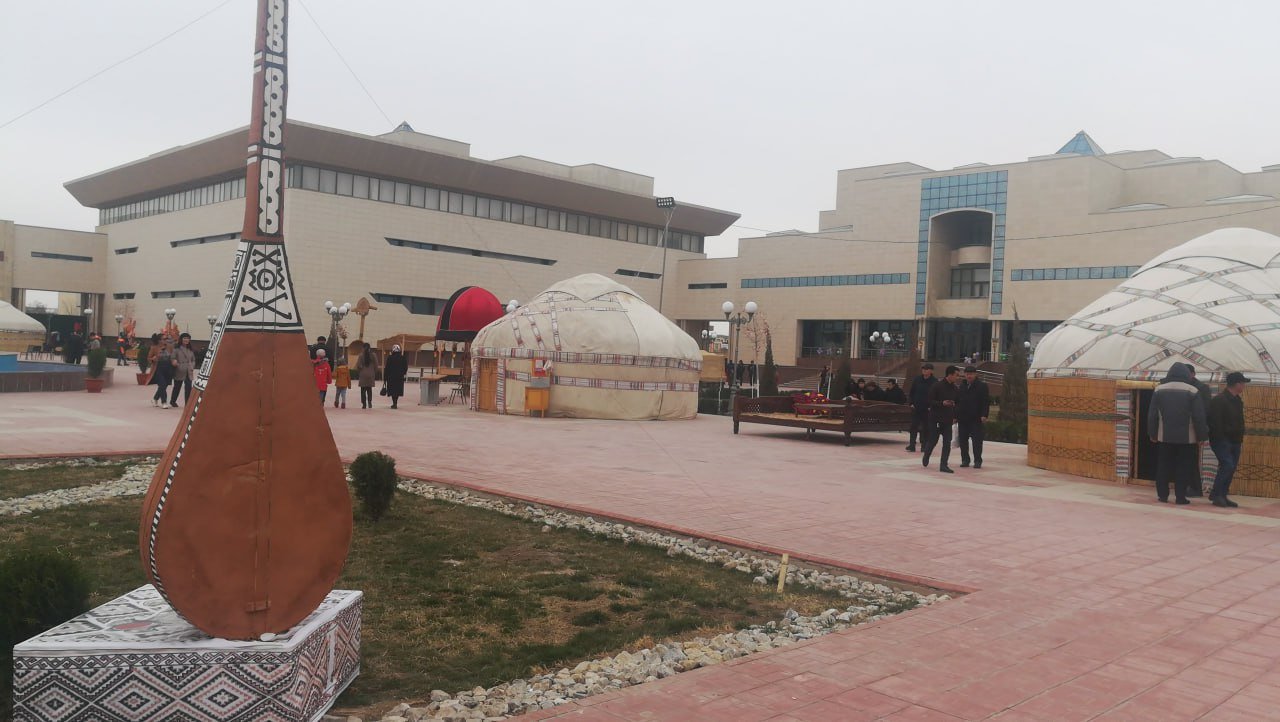Navruz, and Sevitsky Museum
For me what makes a place feel truly homey are pictures and plants, and I took care of this basic need very shortly after my arrival. As the weeks progressed and I visited several of the rural schools, where I was gifted various small pieces of local art, my room décor improved even further. I especially like the wooden boat now moored above my kitchen counter. I am deeply ambivalent about a green knitted pouch that looks like something a first grader or my sister Dadu, who recently picked up knitting as a hobby, would produce. How long is the reasonably polite amount of time one should hang on to something like that? But, unquestionably, plants are the most important part of my home away from home. I have four medium size plants and one big one. Being no plant expert, I don’t know their proper names. But that doesn’t bother me in the least. I give them my own names.
My biggest plant is named Joyce, because she brings me so much joy. I sit in my comfortable chair by the window, where I can either work on my computer or spy on the soccer field. When I purchased Joyce at the bazaar in November she was a bit scraggly because it was the end of the season and she had probably experienced a lot. From the bottom of the pot to the top she is about 1.5 m. I wanted a tall plant that would be at my eye level when I sit in my chair, which is my favorite place. It ‘glows’ best at sunset. The afternoon sun illuminates the wall behind Joyce, whose silhouette gives the illusion I am looking at something much lusher than reality. This remarkably regular show goes on for a few precious minutes before the sun disappears behind the rooftops.
I am quite pleased with the view from my window. Even though my brain knows that the artificial green surface of our school’s soccer field would not fool a real goat for a second, it is still soothing for my eyes and psyche. Just past the fenced soccer field lies the university campus. The first building past the fence separating these two enclaves of learning is the university dormitory. Each evening the windows are lit, and I imagine the students behind those windows busily studying for their next class or dreaming about the last day of school, depending on their program of study. Are they in Sciences or Humanities? A few nights ago I noticed that many of these normally brightly lit windows were dark, the students no longer there. Most of them had gone home to enjoy Navruz, which by far is the most significant holiday in this part of the world, with their families.
Navruz is the most important holiday, not only in Uzbekistan, but in the whole Muslim East! This oriental New Year is directly connected with the coming of Spring and is celebrated on the 21st of March, on the Spring Equinox.
Our students had just completed their Term 3 exam week, and I was sitting in my window chair grading a pile of papers when I heard the music outside. It worked like a magnet. Abandoning ungraded papers, I scooted downstair and joined the festivities. The kids were dancing. There was a huge cauldron on an open fire with two people stirring its contents. The mixture they were so careful not to burn was sumalak. This is a dish with very simple ingredients — newly germinated wheat, oil, flour, and water — but it has huge significance all over Central Asia. This sweet tasting pudding, which does not have any sweetener added to it, is a traditional dish that dates back to pre-Islamic times. It is served only once a year, only during the Navruz festivities. Because the mixture of germinated wheat needs to be stirred for a minimum of 10 hours, it requires a community effort. The scene unfolding before my eyes attested to it. Ayzada, my Grade 11 student, and the Physics teacher stood by the cauldron stirring intently. Ayzada noticed my interest and passed me the long handle of a large spoon with holes in the flat bottom part to make stirring the mixture easier.

“Make a wish”, she said. “It’s customary that when you start stirring you make a wish. It will come true.”
She sounded absolutely convinced. Maybe she just finished wishing for a good grade. I smiled and gripped the handle. Stirring it was not easy. The dark brown mixture was viscous and the long spoon unwieldy. Call me cynical, but immediately I thought of one of my favourite childhood books about Tom Sawyer. In particular, the part where Tom is tasked with a chore of painting a fence. He believed he had better things to do, so he conned his friends into working for him by pretending it was a lot of fun. They even ended up paying him for the privilege of painting a couple of planks. Luckily, I didn’t have to pay anyone to let me stir the pot a bit and make my wish.
I had stirred for a while when I noticed two large crows sitting on the nearby fence observing the festivities. They only completed the scene. I winked at the crows, imagining myself a good witch wishing for the warm Spring and good planting.
As soon as I could, I passed the long spoon to another person and joined the dancing kids. Given loud enough music, open space and the freedom to express themselves by dance, our budding young scientists and academics reverted back to care-free kids; just happy the exams were over and they would soon be leaving for a week of break. Top this off with an organized old-fashioned tug-o-war between the grades and we had a bunch of very happy kids.

There is one side benefit to having students who work very hard most of the time. Any break in their study routine, no matter how small, is welcomed enthusiastically. Only free tickets to Canada’s Wonderland, followed by a private interview with either LeBron or Rihanna would generate this level of enthusiasm in Western students.
I tasted the fruits of our communal labour the following day when the staff all met to celebrate the school Navruz. The home-made dishes were spread on several large tables in the cafeteria decorated for the event. Everything looked scrumptious, and it was not because I was hungry as is sometimes the case. It really looked extremely inviting. Bowls of sweets were fighting for space with plates of salads and savory pastries, and there was an abundance of everything. The piece de resistance was, of course, big bowls of sumalak on every table. I followed the example of one of my co-teachers, spooned a big pile of sumalak onto my plate, dipped a finger in it and licked it. I could not believe how sweet and delicious it was. My colleague assured me again that there was no sugar added. It’s nice to be surprised once in a while. I wish we would all have more sweet surprises in our lives.
The Navruz celebrations gave us a long weekend that not even the Agency was able to take away. With this extra day of freedom, I decided to pay a second visit to the Savitsky museum. This museum is justifiably the pride and joy of Nukus, housed in two modern buildings, and boasting the most extensive exhibit of 20th Century paintings in Uzbekistan. For the first two months of our tenure in Nukus, I kept mispronouncing its name, calling it Sovietsky. I felt no burning need to visit it, assuming that its exhibits were somehow tied to the Soviet rule of the past regime. Finally, someone gently corrected my pronunciation and, consequently, my perception of the museum. ‘Savitsky’ is the name of the artist who donated his art to the museum, and thus started what is now the world's second largest collection of Russian avant garde art, rivaled only by the Russian Museum in St. Petersburg.

During my first visit I explored the first floor, which covers only a fraction of what the museum has to offer, and that first visit was not without its challenges. When I tried to buy my admission ticket, the cashier attempted to sell me a tourist priced ticket, which is more than twice the price of the regular admission reserved for the Uzbeks. That really incensed me. It was not about the money, since the admittance cost was really quite reasonable. But it was a matter of principal. I am not a tourist here. I live here, I even pay taxes here. I tried to explain it to her but lacked the basic topic vocabulary such as government and taxes. So, in my usual roundabout way, I explained to her, “I live here. Every month I give money to the Big Guy. Every month.”
I don’t know if she thought I was a victim of some extortion scheme, or on the payroll of some oligarch who could cause trouble. But she soon grew tired of listening to my terrible Russian and sold me the cheaper ticket.
That thought of government and taxes transported me back to one spring afternoon when Jessie was about 5 years old. Dave’s dad was busying himself with tax returns, not paying enough attention to her, so she wanted to know. “What are you doing, grandpa?’
“Oh, just getting some money ready.”
“Why?” Already at that tender age, Jessie understood the importance of money.
“Well, I need to give it to the government.”
A long, thoughtful pause ensued followed by, “Grandpa, I know what I want to be when I grow up.”
“When I grow up, I want to be a government.”
“What is that, Jess?” Grandpa was probably feeling tired by then, but her answer perked him up.
Second time around, I was not sure if the lady at the museum ticket counter was the same one that had sold me the ticket during my first visit. I may not have recognized her, but she certainly recognized me. She sold me the citizen-priced ticket without any question. She even gave me a smile as she handed me the ticket. It takes no effort on my part to be remembered. Here, I am the towering Valkyrie of Nukus. On this second visit I came by myself. First time around I was able to bribe Dave into joining me by promising him a nice lunch in the café across the street from the museum. They make an excellent lavash, which is the Uzbek equivalent of a tortilla style wrap, but served with lots more cucumber. When I suggested the second visit, Dave suddenly realized that he still had a bunch of exams to grade. I couldn’t blame him. He knows me. It’s not easy to accompany me to any exhibit. I approach my visits in the similar manner I approach reading magazines. Normal people choose an article of interest and read that first. Then they may look at the rest of the magazine jumping around the pages, or not. It depends on how much time they have, and how obliged they feel to pass the magazine on to their poor relations. I am a compulsive reader. When I get hold of a magazine, I feel I should read it from cover to cover. It must be the cheapo in me. I paid for it, I should use it in its entirety. I approach my gallery and museum visits in the same manner. I paid the entrance fee, I feel I should see the entire collection, leaving exhausted behind whoever was foolish enough to accompany me. I am the person you get annoyed with when trying to glimpse the short name of a given exhibit as I stand there unmoving, deciphering the small print that no one else is interested in.
The first room I entered housed works by Savitsky himself. I felt the warm tingle of pleasure of recognition that one experiences when running unexpectedly into an acquaintance in an unfamiliar city. In one of the paintings I recognized my minaret in the old city of Khiva. The one that, having scaled it and survived, gave me wobbly legs and nightmares. And there it was, looking peaceful and majestic rendered in pastel, outliving its creator.
I fall into the ranks of very average people when it comes to art appreciation. I need to understand what I am looking at. Ok, so this is a painting depicting a man with a camel plowing the field. I have never seen a camel engaged in this activity, I am used to oxen, but I can certainly understand the function of it. I like this picture. I have almost no appreciation of abstract art. Five wavy red lines painted in the centre of a white canvas, and I am racking my brain while attempting to look knowledgeable. What am I looking at? Why is this so valuable and why didn’t I think of painting this and selling it?
I spent over two hours browsing the second floor, and had not even peeked yet into the second building. At this pace my cultural needs should be covered well into summer.